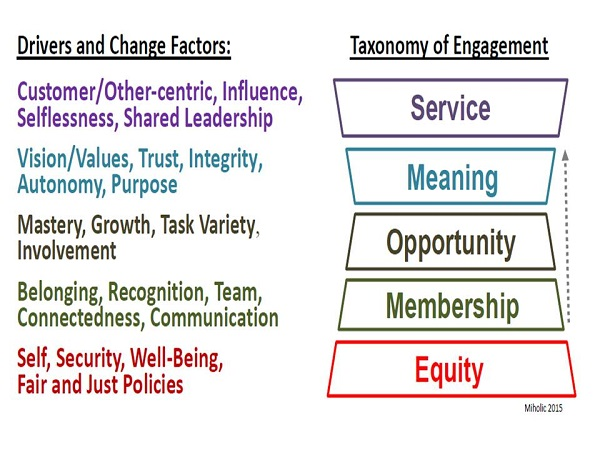ATD Blog
Taxonomy of Engagement: Start With Equity
Thu Jun 11 2015

Assessing engagement and plotting specific strategies to correct organization breakdowns or stimulate improvement is fairly easy. Typical variables rise to the top: communication, growth, involvement, and recognition. Additionally, most drivers and strategies intersect:
Meaningful coaching results in growth and relationship building.
Quality is an effect of valuing and including others.
Solicitation of formative design thinking from those who toil most at implementation helps people gain respect and trust.
Involvement is the foremost recognition that everyone really desires.
However, tricky dichotomies materialize when we begin to grapple with complex human physiological and psychological variables, such as survival, self, relationships, and their related contextual perceptions and behaviors.
An Engagement Hierarchy Model
Simply removing barriers or stimulating key drivers of engagement do not resolve the fundamental hierarchical order of these complex relationships. The engagement hierarchy proposed in this blog post— Equity, Membership, Opportunity, Meaning, and Service—adapted from Barrett’s model (which is based on Maslow’s hierarchy of intrinsic needs) brings more clarity to understanding an unyielding 70 percent nationwide disengagement rate.

The path to stimulating engagement begins with equity and ends with service. The degree to which behaviors move from basic needs and selfishness (or entitlements) to growth and selflessness is the only chance leadership has of significantly moving the engagement needle.
But it’s important to note that the hierarchical structure is reciprocal. Realizing basic needs (equity) at the lowest level requires unconditional intent at the highest level (service). For instance, on the lowest level, employees should know, feel, and believe that their compensation equals that of others, according to the value and performance they bring to the organization. In fact, employees trust that their contributions and value added are proportionately recognized. This psychological need—nested in trust—must be intact to build the relationships and meaningful experiences on which engagement pivots.
Level 1: Equity
Let’s explores the first level of equity, which is perhaps the most rationalized. Yet, if realized dramatically, equity enables all other levels.
This fundamental prerequisite of engagement cannot be overemphasized. When organizations do not systematically and uniformly address dimensions of equity, all other levels are diminished and unlikely to be actualized. Basic needs are met here: safety, security, survival. Moreover, meeting basic survival needs cannot be separated from ethics.
Equity is deeply embedded in trust. Trust fundamentally ensures that the employer cares for employee and organizational well-being. This translates into assurance that the best methods are used to hire the best person for the job. We trust, for instance, that starting salaries and performance adjustments are, as the Blanchard group defines, “comparably fair and just.”
On the macro level, however, inequity remains pervasive; salary and gender disparities are still woven into our social and business fabric despite efforts to overcome forms of discrimination. Workplaces continue to struggle with basic human and civil rights. On the national level, leaders leverage minimum wage as a political rather than moral issue; on the local level, political favoritism, cronyism, and nepotism cripple efficacy.
Consequently, while one may argue the way of business is through networking—and to a degree, such social connections are grounded in confidence and trust—substantial equity work remains unattended in most organizational cultures. To be sure, no level of this taxonomy speaks to prestige, self-preservation, or excess or obtaining favors, position, and trappings.
These are not basic needs but overt indulgences. If all were well, the question of whether “the deck is stacked” wouldn’t be a fixture in sociological curricula. Nonetheless, engagement resides somewhere between Dan Price’s $70,000 shareholding and everyone’s proper equity stake.
Bottom Line
Data from Gallup links 70 percent of the variance in moving the engagement needle to how leaders translate mission, values, and vision into action. Trust is realized when all employees are equitably served and valued. Without equity, the interior scaffolding of the hierarchy collapses.
The second post in this blog series will discuss the interior steps: membership, opportunity, and meaning.
